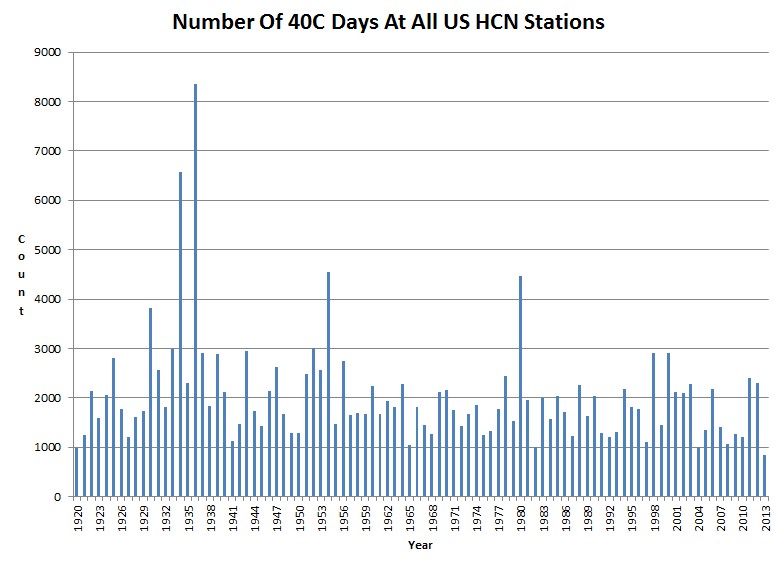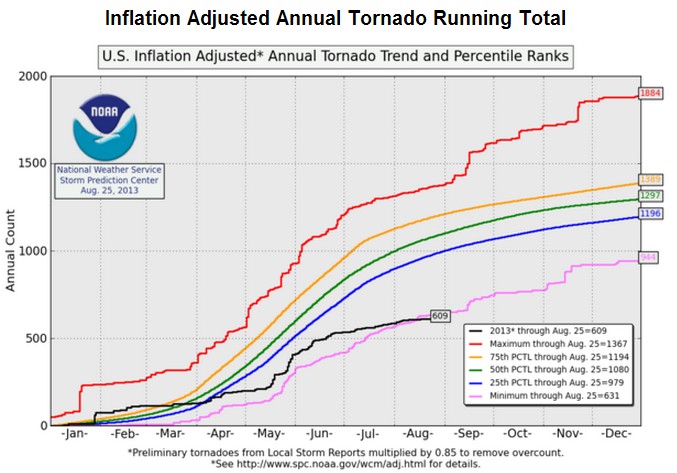The summer of 2013 is over in a few days, and has had the fewest 40ºC temperature readings of any year in the last nine decades. There were only 832 40ºC temperatures recorded in 2013, compared to 8,357 in 1936.
Index of /pub/data/ghcn/daily/hcn/
2013 has also had the fewest tornadoes on record, and zero hurricanes through August.
Inflation Adjusted Tornado Running Totals – Storm Prediction Center WCM Page
Bottom line is that the summer of 2013 has blown away all records for being the mildest and least extreme summer on record in the US.




The following was attributed to Oh-Bomb-Ya upon hearing the news:
“Mission Accomplished” — Erm…. wait, no scratch that….. We didn’t pass the carbon tax yet!! Hold on……. Ahem……. If you think the global warming enhanced weather is bad now, just wait. We need to take firm action on the climate issue and pass that carbon tax NOW!!
YEP: http://www.zerohedge.com/news/2013-08-26/obama-declares-war-climate-change
If you look from 1950 onwards (a date after which man was supposed to have a significant effect on global warming as per IPCC) it looks like a cooling trend or flat by eyeball.
As per the hottest years I mean.
Have to agree!
Before anyone complains about the end of Summer! Meteorological Summer ends on August 31!
http://www.youtube.com/watch?v=_D2XD341xHo
Not only the meteorological summer ends on august 31: http://www.markvoganweather.com/2013/08/26/iceland-storm-snow-potential-uks-first-taste-autumn/
Just what one would expect from a cooling world! There are those around that will be more than happy to say: I told you so!
Pierre has a good article today…
http://notrickszone.com/2013/08/26/leading-ipcc-scientist-concedes-oceans-have-profound-effect-on-average-global-surface-air-temperature/
Bull dust. No trick zone must have it wrong. No leading IPCC scientist would concede that! Their ethics have been bought and paid for. And “IPCC scientist” is an oxymoron.
😀
“Least extreme” is an extreme too! Dear Kev has been vindicated!
How about extremely mild?
No hurricanes, few tornadoes, few hot days, fewer than average fires, bumper crops, record rebound of Arctic ice. The lack of extreme weather is far worse than we thought!
The extremely mild weather threatens us all.
According to the Farmer’s Almanac this winter will be brutal: http://www.cbsnews.com/8301-201_162-57600023/farmers-almanac-predicts-a-bitterly-cold-winter/
Don’t forget it’s looking to be the second mildest wildfire season, too!
And all this DESPITE the ongoing “adjustments” and “homogenizations” to the surface station records. A year in the 1930s used to be warmer than 1998, but that was fixed. I downloaded records from my hometown, then downloaded them again a couple of years later to find that temperatures from the late 1800s and early 1900s had been lowered quite a bit. All that tampering adds up, making it harder to record mild summers. But nature still manages.
40C days don’t magically end on August 31st.
I sense desperation
Yes, you never know! We only need 7526 more of them in September, and we could challenge the record! Excelsior!
Here, Here!!
Desperation is the new normal-:)
Higher concentrations of CO2 increase the radiative efficiency of surface cooling and weakens convection. That explains lower high temperatures and higher low temperatures since CO2 started to rapidly increase since the 40’s. It would be interesting to see what the average temp cycle per station per day for pre 1940 vs post 1940 is using the ISH dataset.
http://www.ncdc.noaa.gov/data-access/land-based-station-data/land-based-datasets/integrated-surface-database-isd
IMO, CO2 causes the average warming and cooling to be less extreme as CO2 concntrations have increased.
The new region 10 EPA chief is blessing us with her presence this week to proclaim the dire hazards of C02 and to stomp out new mining permits and tell the Fairbanks residents, that burning wood is bad, among other fine tuned ingenious & morally superior progressive ideas for saving the planet.
Apparently she doesn’t agree with the least extreme summer weather data-:)
Tracks of all hurricanes on record:
http://gizmodo.com/170-years-of-hurricanes-mapped-in-one-stunning-image-1202093359
The entire SC24 has been a disappointment for many, especially producing these types of numbers at solar max:
Solar_Region_Summary: 2013 Aug 26
# Num Lat.,CMD Long. Area Extent class count class
1823 S10W76 140 60 1 HSX 1 A (Why even count it, Galileo wouldn’t)
1828 N05W26 90 10 1 AXX 1 A (Why even count it, Galileo wouldn’t)
1835 S10E51 12 140 4 CSO 3 B
“Bottom line is that the summer of 2013 has blown away all records for being the mildest and least extreme summer on record in the US.”
Given the paucity of windstorms, maybe another idiomatic expression?
Remember back when global warming was centered over Las Vegas for few days bridging late June and early July?
Yesterday the high was only 76°F in Las Vegas, 25°F below normal and shattered the old record low maximum for the date which was 91°F. Do the math, that’s 15°F the record was broken by. But I did hear a story on NPR about the “unusually late heatwave” in the Upper Midwest, highlighting the Minnesota State Fair and Minneapolis as they reached 97°F yesterday, breaking their record high by 3°F, something that may not have been possible without the aid of global warming. Today’s (8/27) record for Minneapolis is 99°F in 1926.
Would you please provide your source of the temperatures in Vegas yesterday. I can’t find that number anywhere.
Found it here. http://www.nws.noaa.gov/climate/index.php?wfo=vef
Thanks.
In fact, it was the 4th coldest August day on record there and second coldest high temperature.
The 74°F readings on 8/17/1983, 8/18/1983 and 8/21/1957
Another interesting fact I see in the graph: since 1981 — a period of 33 years — there have been only two years that had >2,500 days of at least 40°C. By contrast, between 1925 and 1953 — a period of 29 years — there 13 or 14 years that met this criterion.
Sorry, that should have been between 1925 and 1954; a period of 30 years, with 13 or 14 that met the criterion.
Time to form 400.org as weather at 400PPM is much nicer than it was when CO2 was under 350PPM.